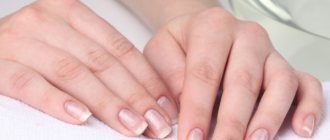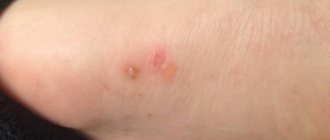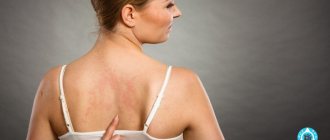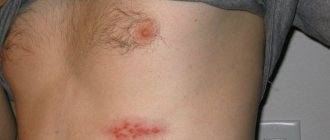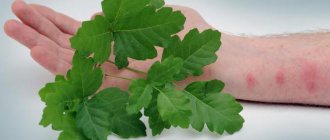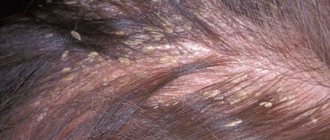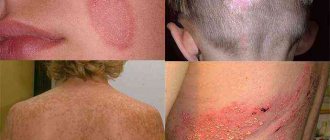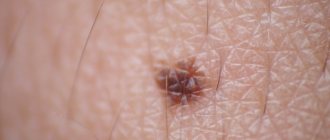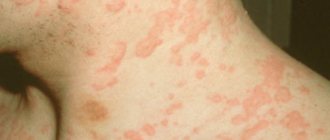( 2 ratings, average: 3.00 out of 5)
Home » Skin spots
Red dots on the body like moles are found in different places. These are probably angiomas - benign structures. They occur in both adults and children, and cause discomfort only in aesthetic terms. But there are other options for the origin of spots. The main question for most patients is whether therapy is necessary to correct the problem.
Reasons for appearance
The areas of the body where moles will appear in the baby after birth are determined during the period of intrauterine development. It is impossible to influence this process from the outside. The main causes of brown moles are:
- genetic predisposition, which is tracked in the location of nevi in the same places in parents and children;
- excessive exposure to the sun and solarium, which provokes increased work of melanocytes - cells that produce the pigment melanin, which provides the skin with a normal healthy color or bronze tan;
- hormonal fluctuations in women during pregnancy and in adolescents during puberty.
The localization of nevi is due to an increased accumulation of melanocytes in certain areas of the body. This is due to the migration of melanoblasts, which form pigment during intrauterine development, which are involved in the synthesis of nerve cells and muscle tissue. Disturbances in the migration of melanoblasts lead to the fact that by the time the child is born, clusters of melanocytes do not fully mature. As the cells mature, they begin to produce a pigment that gives the cell junction a brownish hue. This happens in the first years of a baby's life.
Dangerous and non-dangerous moles
Ordinary nevi do not cause any discomfort to their carriers; sometimes they even disappear without a trace. Their shape is stable, size and color remain unchanged.
But benign moles are sometimes removed to prevent their degeneration if they are of rather large size (pedunculated) and are located in areas of the body where a person constantly injures them (during vigorous activity or parts of clothing).
Remember dangerous moles in the photo and be vigilant!
If nevi degenerate into cancerous moles, this is dangerous, since such neoplasms quickly metastasize to other organs.
Therefore, it is very important to see signs of malignancy in time.:
1. The shape of the mole changes, it loses its symmetry and begins to grow in one direction. 2. The edges of the nevus become uneven (“cut up”, “torn”). 3. The color of the mole is uneven and contains yellow, red or black inclusions. 4. The nevus grows or “shrinks”, its size changes quickly. 5. The texture of the mole becomes different, smooth becomes rough, bumpy becomes flat, etc. 6. Loss of hair growing from the nevus. 7. Itching, peeling and burning in the mole area. There are several reasons why a nevus itches: – pathological cells multiply; – there are active processes of death of healthy tissues; – the area around the formation becomes inflamed and swollen. 8. The appearance of microcracks and ulcerations. 9. Bleeding and soreness of the mole.
Cancerous moles (melanomas): photo
Features of brown moles
The International Classification of Diseases ICD-10 assigned brown melanoform nevi the code D22 with additions based on location. In adults, there are about 50 pigmented formations. Teenagers and pregnant women become covered with nevi more often than others. The definition of “melanoform” means that the growth consists of melanocytes. There are several types:
- Convex - intradermal/epidermal.
- Flat - borderline.
- Hanging ones are papillomatous.
- Verrucous.
- Nevus of Sutton.
- Dysplastic.
Intradermal and epidermal are a light brown mole that protrudes above the surface of the skin. They are distinguished by the depth of location of the pigment cells: in intradermal cells the pigment is located deep in the dermis, in epidermal cells in the epidermis. The color of the formation may vary slightly from flesh-colored to brown. Often hair grows from them, which indicates their good quality, since the cells retain their function and do not disrupt the channels for hair growth. They may darken over time.
A border nevus is a flat, brown mole. The shade ranges from brown to black, the dimensions do not exceed 5 mm, and most often looks like a dot with rounded symmetrical edges. It is more difficult to damage such a formation. The cells are benign and rarely degenerate into melanoma.
They look like convex, loose formations of brown color of various shades. Localized on the extremities, armpits and neck. Warts may peel off. Dry skin provokes itching and self-infection of the virus in other parts of the body. Some papillomas are located on the stalk. With a weak immune response to the virus, the disease progresses and new formations appear. Treatment includes hardware removal of the growth and stimulation of the immune system.
Verrucous nevi are often confused with viral warts; outwardly they look like lobulated, rounded projections above the skin of a dark brown color. They are most often located on the face and scalp, and are also found on the body. They increase in size as the child grows, rarely exceeding 1 cm in diameter. This type is susceptible to injury and can bleed more often than others.
Sutton's nevus is a brown spot with a light, depigmented area of pink skin around it. This encircling ring is well visualized, has a distinct color, and a rounded shape. Rarely encountered, not dangerous.
Dysplastic ones have an uneven color, one part of it may rise above the other, and there is an asymmetry in size. This formation is classified as melanoma-hazardous and requires specialist supervision. The probability of melanoma if there are more than 50 moles of this type on the body and skin cancer in close relatives is 60-100%. Not every formation resembles a dysplastic nevus. Only the results of histology determine its type. An ordinary person cannot visually distinguish dangerous pigmentation from safe ones; for a diagnosis, one should contact a medical institution.
Ways to deal with red moles on the skin
Removing red moles using instrumental or surgical methods is a last resort. Although, if the neoplasm is truly benign, then the patient can get rid of it at his own request. Especially if it is located on the face and causes aesthetic discomfort.
Other indications for removing red raised spots on the body are:
- frequent friction and inflammation of tumors,
- rapid increase or proliferation of spots,
- the addition of secondary unpleasant symptoms: itching, peeling, burning, swelling.
Important! Under no circumstances should you try to get rid of red moles using home methods! It is especially dangerous to burn them with acid or alkalis. Such rash actions can lead to serious damage to its cells, which can subsequently develop into cancer.
If a red mole on the chest, neck, face or other part of the body is problematic, that is, it gets wet, turns purple, and often becomes inflamed, then it is advisable to consult a dermatologist-oncologist rather than a regular dermatologist. An experienced specialist will be able to assess the nature of the tumor even by eye, and will prescribe the necessary tests in order to be absolutely sure that the growth is benign.
Is the brown color of a nevus dangerous?
A brown mole is completely normal. Heterogeneous coloring together with other signs of melanoma development indicates the presence of a pathological process occurring in the formation. If the growth does not have any signs of degeneration other than color, most likely we are talking about a dysplastic nevus, which is benign, but has a slightly higher likelihood of malignancy.
When it comes to flesh-colored formations, dermatologists are unanimous in their opinion that such a mole is safe. The number of cases of non-pigmented melanoma tends to zero, but such cases are known to science. Most malignant tumors are dark brown or black in color.
Stains
Freckles . They appear under the influence of sunlight due to the fact that melanocytes begin to secrete too much pigment. Freckles are not a cause for concern, except that they can spoil someone's mood. Regular sunscreen will help prevent their appearance.
Cafe au lait stains . Flat, dark areas on the skin that are round or oval in shape, usually several centimeters in diameter. Such spots are present from birth and should not scare you. However, too many of these spots may indicate a hereditary disease and the possibility of malignancy.
Lentigo . Flat brown spots appear on the skin when exposed to sunlight. As a rule, they occur in older people, but can also be congenital. If lentigo appears in the facial area and grows in diameter up to 2 cm, there is a high risk of malignant degeneration.
Which mole needs to be removed
Having an idea of the number of your own nevi and their appearance, it is easy to monitor their condition. Signs of the onset of pathological processes in a pigmented area of the body are as follows:
- lack of symmetry around at least one axis;
- jagged, uneven boundaries of pigmentation;
- bleeding or other discharge from the formation;
- uneven coloring of the mole, dark inclusions, the appearance of a rim or edging;
- dimensions exceeding 6 mm in diameter;
- progressive growth, the nevus may hurt and itch.
Even if one of these signs is present, it is necessary to visit a dermatologist, who, if necessary, will refer the patient to an oncologist. The doctor will recommend how to remove the formation and do its histological analysis.
The following formations are considered signs of benign pigmentation:
- pedunculated, width less than 2-3 mm;
- long-term existence without any changes;
- surface hair growth;
- the skin pattern is preserved on the pigmentation;
- pale color;
- the structure is softer than the skin.
- smooth edges, axis symmetry.
These signs do not guarantee the absence of pathology, but the occurrence of cancer cells in such nevi is unlikely.
The following hardware techniques quickly and reliably remove skin defects:
Moles can be removed surgically under local anesthesia. This mainly occurs when a malignancy is suspected. Laser removal and cryodestruction do not allow testing the material for the presence of cancer cells. These methods are used to eliminate only good moles that have been examined by a doctor, that is, the method of removing the defect is always determined by a specialist.
Pharmacies offer many drugs for skin treatment, most of them require long-term exposure, which can trigger the development of tumors. This is why you should not self-medicate.
Diagnosis of the disease
In addition to a possible serious illness, there are simple reasons for such an annoying defect. Elderly people perceive it as a “bell” from the body, indicating skin aging. Guided by the most trivial explanation, one cannot immediately discard other potential possibilities for their appearance:
A common common cause is injury to the epidermis. Consequence of hair removal, for example.
Usually causes unpleasant microtrauma;
Insufficiency or complete absence of vitamins K and C is also a factor in the appearance of red dots. Often the main manifestation is the fragility of the wall of the blood tubes, leading to frequent hemorrhages even with the slightest influence. A strong handshake, the pressure of a bag harness, or simply throwing a ball manifests itself as internal injuries. Showing a sign like a red alarm, it’s clearly time to visit a doctor. Sometimes it seems like an insignificant problem, apart from the presence of marks, you can’t just observe it. The presence of a cause means the further appearance of only more of them.
The next popular factor in the appearance is the development of hemangiomas. The variant is often called “colored moles.” Also being a type of cancer, it rarely becomes malignant. Delivering mainly only aesthetic discomfort, these tumors develop through blood and lymphatic vessels. Appearances include different parts of the body: starting literally with the face, ending with the tips of the heels. Another important point is that a few spots can simply be ignored; a subsequent larger number of red circles causes a more gloomy expression on the owner’s face.
It is important to understand the hepatic etiology. Possible pancreatitis, hepatitis or cirrhosis of the liver. The spots themselves have some differences from their other “relatives”: they usually appear on the upper limbs, the body itself, the appearance resembles small rays of the sun around the spot, called “liver stars”. The phase of acute manifestations of the disease is easily tracked by the owners with the rays - they simply observe an increase in size.
The last important one is rheumatological cause. Most often, lupus, arthritis, joint problems. Autoimmune processes play a primary role, creating false processes of antibody action against one’s own cells. Externally, it manifests itself in the choice of a specific area for the appearance of spots (the area around the eye, for example), in various forms of rash: papules, spots, dots, bruises, blistering formations. They often cause insurmountable itching.
Precautions and possible complications
If there are moles on the body, the recommendations of experts are as follows:
- The patient must monitor his skin, keep a record of old and new nevi, write down their sizes, and, if possible, record their shape and size by photographing.
- See a doctor once every six months or annually (depending on the number of pigmented dots).
- Remove moles that are subject to injury, friction, sun exposure, located in places inaccessible for self-examination, and that spoil the appearance.
- Dispose of only in medical institutions.
- Use sunscreen when exposed to the sun.
The most dangerous complication that can arise from moles is melanoma. The disease can begin not only from a nevus, but also on intact skin, so if any birthmarks appear on the skin, you should make an appointment with a specialist.
Greetings, friends. Has it ever happened to you that when examining your skin, you saw the appearance of new rashes in the form of black dots? Then you were probably worried about what it could be.
Undoubtedly, you need to look closely at all skin rashes, monitor their change in color and size over time to understand whether it is worth worrying about. Let's figure out what black dots that look like moles mean.
Why do mole-shaped spots appear on the body?
There are many conditions that can cause brown spots on the skin. The main causes of neoplasm can be:
- ultraviolet light in sunlight;
- trauma caused by skin diseases;
- medications that have side effects on the skin.
Also, in addition to this, there are some skin diseases that cause dark spots:
- Acne.
- Melasma.
- Melanosis.
- Poikiloderma Siwatt
- Erythromelanosis follicular
- Hyperpigmentation.
In addition to exposure to sunlight and disease, aging and genetic makeup play an important role in determining susceptibility to developing brown spots.
Reasons for appearance
So, the causes of such rashes may be:
- influence of ultraviolet radiation. After the summer holiday, black spots appear on the body, which are caused by being in the sun during high activity hours without protective equipment. Even ordinary pigment spots can turn into a malignant state if sunbathing is not dosed and without appropriate protection;
- changes in the functioning of the hormonal system. Often occur in adolescence, during menopause and pregnancy, due to a sharp restructuring of the functioning of body systems;
- heredity. This factor affects the concentration of melanin in the body, which can become one of the causes of rashes on the body;
- stress, anxiety. Try to minimize stressful situations in life, as this affects the state of the hormonal system.
Why do they appear?
Nevi are essentially benign skin formations.
Some people get scared when they see many moles on their body. What does this mean for a specialist? Only that the patient’s body is prone to accumulation (accumulation) of melanin in the surface layers of the epidermis.
The reasons for the appearance of numerous or single nevi are varied.:
- exposure to ultraviolet radiation, one of the most common factors in the formation of moles due to increased melanin levels during tanning;
- traumatic damage to the epidermis, systematic violations of the integrity of the skin contribute to the appearance of pathological changes in it;
- exposure to radiation, which rapidly changes normal skin cells;
- consumption of harmful products (GMOs, fast food, alcohol) and smoking, these habits negatively affect metabolic processes in the body.
- endocrine disorders and diseases, any changes in hormonal levels can cause the appearance of skin pathologies, pigmentation, moles;
- hereditary predisposition, the presence of various nevi in the family.
Are blackheads dangerous?
The danger of black spots on the body, similar to moles, can be determined by several parameters:
- the diameter of the formation should not be more than 4 mm;
- edges are smooth;
- no pain;
- does not increase in size when observed over several months.
If the formation of blackheads is detected by an adult over 16 years of age, the best advice would be to consult a dermatologist. After the examination, the doctor gives recommendations on skin care, or may refer you to an oncologist.
It is better to see all specialized doctors as early as possible to exclude the formation of malignant tumors.
There are situations when black dots appear on the mole itself. This should not cause alarm, as it occurs due to the aging of the human body or is a consequence of mechanical damage, for example, when changing clothes.
This also occurs due to papillomavirus - a fairly common virus that causes the formation of papillomas on the human body.
What is angioma, what can it be, and why is it dangerous?
What do red moles on the human body mean? Angiomas are neoplasms that form from blood vessels. Blood circulates inside them, so if they are injured, intense bleeding can occur, which is sometimes very difficult to stop.
Red moles are mostly benign in nature, but still, they require special attention due to the fact that:
- when injured, they become easily inflamed,
- they tend to grow
- new growths may appear on the body throughout a person’s life,
- some types of angiomas, in particular hemangiomas, can become malignant (rare, but still possible).
Angiomas have their own classification, according to which they are divided into:
- Pineal. Such a vascular mole is a small convex neoplasm, which can be clearly seen due to the fact that it protrudes sharply above the surface of the skin.
- Nodular, the main feature of which is the complete absence of capillary branches. This growth looks like a red dot on the skin, like a mole, and occurs when a blood vessel comes to the surface of the skin.
- Branched (spider-like). The appearance of such red moles on the body is a consequence of the branching of blood vessels from the main, “maternal” angioma.
- Flat. These red moles on the skin look like small lumps or dots.
On a note. If the neoplasm appears due to an abnormal development of blood vessels and their plexus, then it is called a hemangioma. It looks like a red convex mole, and it is this mole that is most susceptible to mechanical damage, followed by bleeding and inflammation.
A rarer type of such tumors is lymphangioma. It appears due to disruption of the human lymphatic system.
Precautions and prevention measures
As you know, it is always easier to prevent a disease than to treat it later.
Therefore, take into account the following recommendations:
To quickly get rid of blackheads, acne and pimples, as well as to rejuvenate your facial skin, we recommend that you familiarize yourself with this effective remedy .
- dose sunbathing and time spent in the open sun during periods of high activity from 10 a.m. to 6 p.m. Be sure to apply protective products to your skin;
- Avoid injury from clothing and mechanical damage. Do not try to remove skin lesions yourself. All manipulations must be carried out by a doctor after performing the necessary tests, using modern removal methods. Lasers and instruments used in medicine will remove all moles and spots without causing scars. You will only need to follow the recommendations for 10-14 days;
- If your skin is prone to the formation of various rashes and blackheads, it is better to avoid visiting a solarium. Artificial tanning is created by exposure to fairly strong ultraviolet radiation.
How and with what to get rid of papillomas on the neck?
- Why do papillomas occur on the neck?
- Types of papillomas
- What to do?
- How can I be cured?
- Features of treatment
- Complications
- Prevention
Papillomas on the neck can appear in men and women of any age. We will now look at where papillomas come from, what these formations are on the skin, why they are dangerous, and how to cure them.
Why do papillomas occur on the neck?
Why papillomas appear is the first question that a person should ask himself when he sees that small warts have appeared on the neck. It will not be possible to treat papilloma until you can understand the causes of its occurrence. The appearance of papillomas is caused by the entry of the papilloma virus into the human body.
It is quite easy for the virus to penetrate the body, since there are several ways for this:
- Sexual contact (especially without the use of contraceptives), the virus can also be transmitted through kissing.
- Domestic use (use of personal belongings and hygiene products of a sick person), as well as in public places when in contact with a handrail or door handle.
- From mother to child, during its passage through the birth canal, if a woman has papillomas in the vaginal area.
It is impossible to find out exactly why the infection appeared in a person, since every day we are faced with hundreds of sources of infection. But it is necessary to know the routes of infection in order to try to protect yourself from the virus and the consequences of its appearance in the body.
This virus is the original reason why growths appear on the skin. But the papilloma virus can remain in a latent, dormant state for a long time, and only a provoking factor can become an impetus for the appearance of such skin defects. A person can live with this infection for years and be a source of infection and not even know it. A healthy, strong body can fight the papilloma virus for a long time, but if the immune system weakens, the disease will manifest itself in all its glory, and then a papilloma or wart will appear on the neck. If the body weakens more and more, then papillomas grow, there are already a large number of them on the skin, and the longer they exist, the more difficult it is to remove them.
Video
Now it’s worth considering the reasons that contribute to the activation of the virus, which is why papillomas form on the neck:
- Loss of immunity due to viral or bacterial diseases;
- Failure of the immune system during pregnancy;
- Stress and constant overstrain (both mental and physical);
- Avitaminosis;
- Hormonal imbalance;
- Errors in diet for a long time;
- Alcohol and tobacco addiction;
- Dysbacteriosis;
- Exacerbation of chronic diseases;
- Seasonal allergies.
Types of papillomas
Papillomas on the neck can vary in appearance depending on the size or type. Sometimes they are small or large, multiple or single, locally located or in groups that cover the entire neck. Papillomas can occur absolutely anywhere in the neck, and over time they can spread to the face and chest, back and arms. Such changes mean that the virus is actively multiplying, and the disease is progressing, and the immune system is not able to cope with it on its own.
The growth on the skin of the neck can be different in structure, and therefore they are distinguished:
- Thread-like - first a yellowish bump is formed, it grows and lengthens, transforming into a stalk with a ball at the end and resembles a falling drop.
- Flat - growths slightly rise above the skin and are yellowish, pink or brown in color. Usually there are many small growths that do not exceed 5mm in diameter.
- Simple or vulgar, usually called warts - the formation on the neck is round and brownish, rising above the skin by several millimeters.
What to do?
If warts or papillomas grow on the neck, they not only look aesthetically pleasing, but also pose a threat to humans, as they can easily be injured by collars, scarves, and scarves.
And if warts have tormented a person, then you should not rip them off or burn them yourself, as this can only cause harm. A dermatologist should tell you how to get rid of papillomas on the neck and the virus in the body: whether it is necessary to remove the growth, or you can get by with medications.
It is better to consult a doctor for the reason that papilloma viral infection in rare cases causes cells to turn into cancer cells, and then they cannot be removed by many means. The doctor must decide how papillomas are removed in this case; he will study the type of virus in the patient’s body and determine the degree of its malignancy.
If a lot of warts appear and they do not go away, then this is a reason to change treatment tactics and choose another better medicine or folk remedy.
A folk recipe will get rid of papillomas. Take the simplest...
This is what our grandmothers did. The warts will go away in 10 days. Just take...
How can I be cured?
Treatment of the virus should be carried out simultaneously with the removal of warts, only then will there be meaning and effect from all actions. You can remove a wart from the neck with medication, folk remedies, using hardware techniques. The fight against the virus is carried out using antiviral drugs and immunomodulatory drugs. How exactly a person is treated for the papilloma virus and the removal of warts from the neck in various ways can be found in the table.
Category
Examples of funds
Operating principle
| Drug treatment | Cryopharma; Verucacid; Super clean; Feresol; Oxolinic ointment; Lapis pencil; Salicylic ointment; Papillomas patch. | Any ointment should be applied to clean skin according to the instructions. It is necessary to smear only the affected areas, without protruding onto the healthy skin of the neck. Ointments and plasters will help make the wart dry to the very root and fall off. Also, most drugs have an antiviral and anti-inflammatory effect, due to which the problem not only disappears externally, but also internally. |
| Hardware treatment | Laser removal | The laser penetrates into the very depths of the growth on the neck and eliminates it at the very root. After such treatment, there is a possibility of scarring and formation, and the virus does not disappear from the body. |
| Cryodestruction | The wart is frozen with liquid nitrogen and then falls off on its own. If you decide to remove papillomas in this way, then keep in mind that there is a possibility of affecting healthy tissue, since it is impossible to accurately calculate the degree of damage. Cryodestruction is good because it does not leave scars on the neck, which is very important for appearance, but there is always a possibility of relapse. | |
| Electrocoagulation | The high-frequency current burns the wart layer by layer to the very root. The procedure is performed under local anesthesia. Within ten days, the skin on the neck will recover without a trace, if you do not tear off the crust that has formed at the site of the wart. | |
| Folk remedies | Celandine juice; Potato juice; Wormwood juice. | These products are used to apply lotions to warts and papillomas, generously lubricating the affected areas of the skin. A bandage or plaster is applied on top. |
| Garlic; Aloe leaf; Walnuts with kerosene (soaked); Kolahnoe leaf. | These plants are applied with the juicy side to the warts (cut in half so that the juice can lubricate). Be sure to bandage or stick a bandage on. Keep the bandage on for several hours, preferably overnight. | |
| Ammonia; Iodine; Castor oil; Hydrogen peroxide; Egg white; Tea tree oil. | Apply to papillomas and wait until completely dry, do not wash off or wipe, then the effect is achieved faster. |
If you decide to treat the virus and remove papillomas at home, be sure to consult a doctor to avoid an unwanted allergic reaction of the body.
Features of treatment
Any treatment should be coordinated with a doctor and a course should be drawn up so that the therapy includes antiviral drugs, as well as the removal of the growths themselves from the patient’s neck. Hardware treatment alone will not bring lasting results, and papillomas will reappear after a while. But only antiviral drugs will not quickly eliminate warts, since it is very difficult to remove this virus from the body.
An important step in the treatment of papilloma viral infection is strengthening the human immune system. To do this, you can drink various teas and infusions (echinacea, chamomile, rose hips, currants, lemon), and also take pharmacy vitamin complexes. It is necessary to begin treatment of concomitant chronic diseases, if any, then it will be easier for the body to fight only the virus, and not to scatter its forces on a thousand small problems.
But if this happens by accident, then all measures should be taken to avoid infection in an open wound:
- Wash your hands to keep them clean;
- Take a cotton pad and moisten it with 3% hydrogen peroxide;
- Place the disc on the wound and blot well;
- You can apply a special pharmaceutical antiseptic to the wound;
- Cover the damaged area of the neck with a bactericidal plaster.
If the warts itch and the skin around them hurts, you should tell your doctor about it. Such symptoms may indicate the degeneration of papillomas into a malignant tumor, and then the current treatment may not be appropriate and should be replaced.
Video
Complications
The human papillomavirus, which manifests itself by the appearance of warts on the neck or any other part of the body, can cause complications for the body that not only cause discomfort, but also pose a threat to a person’s life.
Such complications include:
- Inflammation of papilloma - if the wart is inflamed, the skin around it becomes swollen, red, and the person feels pain and discomfort. This phenomenon must be eliminated, and basic hygiene products will help with this - soap, peroxide, fresh air for the neck.
- Papilloma injuries - a torn, cut or punctured wart poses a danger because it can get infected and become inflamed, and also because frequent injuries can contribute to the degeneration of healthy skin cells into cancerous ones.
- Malignization is the process of malignancy of papilloma, as a result of which a cancerous tumor can form, which, if left untreated, can affect the blood and lymph flow, and also begin to grow into healthy areas of the neck.
Such events should be avoided and checked regularly to monitor the status of the virus in the body. If this is not monitored, the outcome for a person may not be the most favorable.
Prevention
It is important to adhere to standard rules of protection and hygiene to reduce the risk of the virus entering the body:
- Strengthen immunity;
- Lead a healthy lifestyle;
- Observe the rules of personal hygiene;
- Treat diseases of any etiology in a timely manner;
- Do not have promiscuous sex life and use contraception;
- Undergo regular medical examinations and tests.
The human papillomavirus is difficult to cure and difficult to avoid catching.
Therefore, it is important to have such a strong immune defense that the virus simply cannot manifest itself and thereby cause trouble in the form of papillomas on the neck. For quick and safe removal of papillomas, the best dermatologists and oncologists recommend the remedy for papillomas “Papilite”. This is a natural remedy that, having a gentle effect on papillomas, removes them without causing harm to the body. In addition, “Papilight” restores the body’s immune system, eliminating the reappearance of papillomas. The product has no contraindications, its effectiveness and safety have been proven by clinical studies at the Research Institute of Dermatology.
Find out more »
Signs of dangerous rashes
If you notice that a mole has suddenly begun to change color, increase in size, has uneven edges along the contour, there is an inflammatory process, the mole does not heal, or itches - this is a very serious reason to immediately consult a doctor.
All these symptoms can occur with melanoma, a malignant skin tumor that develops very quickly and is difficult to treat.
Therefore, it is extremely important to diagnose this disease at the earliest stages of development by a doctor, and not by a cosmetologist.
Black spots on the body that look like moles can be both dangerous and harmless. The main thing when detecting these formations is to independently observe changes in size, color, and symmetry. For any sudden changes, you should consult a doctor.
If there is a threat of a malignant formation or an unaesthetic appearance, the “unfortunate” place of formation of a mole may influence the decision to remove it with simultaneous histological examination of the tissue, which will eliminate the possibility of an unpleasant diagnosis.
After removing the rash, it is advisable to strictly follow the doctor’s instructions; this will help the wounds heal faster and prevent relapses.
With this we say goodbye to you, dear readers. Let your skin be healthy!
OUR READERS RECOMMEND!
For the treatment of pimples, acne, acne, blackheads and other skin diseases caused by adolescence, diseases of the gastrointestinal tract, hereditary factors, stress conditions and other reasons, many of our readers successfully use the Elena Malsheva Method . After reviewing and carefully studying this method, we decided to offer it to you.
Every person has birthmarks of different types, textures, colors, and shapes on their body. These harmless formations arise in the epidermis from melanocytes and grow in clusters. The scientific name of a mole is nevus. This medical term applies to all skin abnormalities.
However, these so-called “floaters” can hide the most aggressive malignant tumor – melanoma. Therefore, you should know what dangerous moles are and be able to recognize the main differences between benign and malignant ones. Cancerous transformations most often occur on the basis of pigmented skin tissues.
Elimination of discomfort
Treatment of this defect depends etiologically. We need to forget about its symptomatic form. Yes, it will remove the unpleasant appearance of your own body. But it will not in any way affect the underlying disease, which further exposes the body as a whole to suffering.
Observing a regular picture of formation, perhaps in a special form, in too visible places, you cannot postpone a visit to the appropriate specialist. A small amount is a tolerable inconvenience. The multitude of the organism shows the obvious danger within it. Later it manifests itself in intensification, exacerbation of diseases, ignoring the body’s help signals.
Sakania Luiza Ruslanovna
Dermatovenerologist, cosmetologist, trichologist
Ask a Question
Treatment of cancer symptoms (skin/vessels) is carried out by immediate therapy with X-ray irradiation, surgical removal of the tumor, or further excision in case of benignity;
When diagnosing the initial stage of hepatic cirrhosis or a form of hepatitis, a detoxification technique is prescribed, first of all. Late symptoms suggest various toxic blockers, liver protectors. Diet will also become an important aspect of the patient's life. Refusal will have to be accepted, first of all, alcohol, salt, mineral (water). Priority must include bed rest, weight control, and hydration.
Having seen the cause of the gastroenterological path, a competent doctor prescribes a mandatory individual diet. The patient's needs should include medications that eliminate possible unpleasant burning sensations and pain.
Joint problems also cannot be ignored. A qualified specialist will immediately prescribe physical therapy. The composition includes wave, laser or magnetic methods. The set of medications includes muscle relaxants and non-steroidal drugs.
These are the current technologies of traditional medicine, using koi, patients are completely cured. The use of folk remedies should also be excluded. In addition to being useless, it can also cause additional harm to the body.
What moles are dangerous?
Cancerous moles, like regular ones, consist of melanocytes. But this is an aggressive form of the tumor, prone to rapid spread and damage to other organs. In this regard, it is recommended to be careful with such pigmented skin formations as:
Atypical nevi
This type does not look like a regular birthmark because its size is larger than a pencil eraser, its shape is unclear, and its color is uneven. Moreover, the potential danger is posed by congenital formations, not acquired ones. Most of them are inherited and are larger than 1 cm.
Prevention of malignancy
Preventive methods for reducing the risk of malignancy of moles include:
- limited sunbathing, cancellation of visits to the solarium;
- minimizing skin trauma;
- maintaining a healthy lifestyle (healthy eating and avoiding bad habits).
Brown spots, similar to moles or birthmarks, are spots that form on the skin and range in color from light brown to red or black. Their appearance can be caused by various reasons, but one of the most common causes is exposure to the sun. These spots are also known as dark spots, age spots, or hyperpigmentation. The spots can appear on the face, arms, shoulders, arms, forehead and even on the scalp of bald people.
Dangerous moles: signs
Color Changes
A mole that has begun to change color is potentially cancerous. For example, one-color pigmentation has acquired some other spots around or in the middle.
Height change
An important feature is a change in the height of the previously flat spot and density (thickening).
Painful sensations
The mole hurts, the surface becomes larger, erosions appear, the release of fluid, purulent masses or blood appears.
Satellite pigmentations
The skin around the formation is also distinguished by redness, swelling or the presence of new color spots, the so-called. satellite pigmentations.
Itching and burning
There are sensations such as tingling, burning, and the mole itches.
Consistency changes
For example, a mole softens, is divided into small pieces that break off easily, or resemble scratches that do not heal.
Types of red dots - angiomas
Typically, red dots on the body do not cause pain and do not exceed a diameter of 2 millimeters. They don't grow any further. Cases when they begin to hurt, itch, or cause discomfort in general well-being are very rare. Moles can appear anywhere on the body. If, when such spots appear, unpleasant, painful sensations appear, or the temperature rises, you should immediately run to the clinic.
Red dots differ from each other in the reasons for their appearance and shape; they usually consist of small capillaries and are pink or red in color. According to their form they are divided into:
They can also be divided according to their structure and the results of histological examination. If an ordinary angioma grows, then a large mole appears, which is called a hemangioma.
Which moles are potentially dangerous?
There are certain categories of birthmarks that are prone to transform into a malignant form. All of them refer to abnormal skin lumps.
1. Nodular pigmented nevi: usually brown or black moles, round and flat.
2. Skin pigmented nevi: they have a raised appearance, pale color, and sometimes a hairy surface.
3. Connecting nevi combine elements of different formations.
4. Halo nevus is a pigmented area of skin surrounded by a discolored white ring.
5. Dysplastic nevus (otherwise known as Clark) is a specific neoplasm.
6. Spitz nevus: looks like a tumor-like growth on the skin. This spot is pink (but a combination of different colors is possible), dome-shaped, prone to bleeding. May have a hole through which liquid leaks. 7. Blue nevus has one of the shades of blue, shows well-defined borders, any size (but most often does not exceed 1 cm), looks like a lump under the skin.
Removal
Many people want to get rid of birthmarks and nevi not only in cases of malignancy (pathological change), but also to correct a cosmetic defect.
However, removal is carried out at the oncology center for people with malignant tumors and with a high probability of degeneration of nevi.
Often the indication for surgery is the localization of moles on the body: on the scalp, on the neck, on the chin, in the area of the shoulder blades.
Methods for removing nevi (with information on how much it costs to remove them):
- surgical, using local anesthesia and a scalpel (in municipal surgical hospitals, according to indications - free of charge, in medical centers from 300-500 rubles)
- cryofreezing with liquid nitrogen (1000-1500 rubles);
- electrocoagulation - cauterization with electric current (600-1300 rubles);
- photodynamic - ultraviolet irradiation (1000-1200 rubles);
- laser - removal of moles with a beam (800-2000 rubles);
- radio wave, destruction of nevi by shock radio wave (RUB 700-1400)
The choice of method for removing moles is made by the doctor; prices for these procedures depend on the size and type of nevus.
THE MAIN DIFFERENCES OF BENIGN MOLES FROM MALIGNANT MOLES
A number of characteristics allow you to accurately determine which moles are dangerous. The benign formation is not asymmetrical. If you draw a line through the middle, then both sides will correspond to each other.
A cancerous lump does not meet these requirements.
Unlike melanoma, a common pigmented spot has smooth, rather than jagged, borders.
The presence of colors and brightness is another exciting symptom.
The formation changes size over time and becomes larger than 6 mm. Noncancerous nevi look the same. You need to be alert if a mole begins to grow or gives other unusual signals regarding its general condition.
The only way to accurately establish a diagnosis and confirm or refute suspicions of cancer is to conduct a histological examination of cells using a biopsy.
The meaning of a mole on the back
Moles on the back and on its upper part are characteristic of people with high demands on themselves and others. They are often obsessed with a healthy lifestyle, while not having the least bit enviable health. Such moles often indicate problems with the lungs in men or bronchi in women. According to Slavic beliefs, moles on the back are a sign of the betrayal or deception of a loved one in this or a past life. This feeling often haunts women, making them suspicious and nervous; this must be fought, otherwise you can end up with serious mental disorders. The owner of this sign is a reliable partner, a thoughtful interlocutor, and a good professional. Often he is endowed with many talents in different areas of life.
Mole on a woman's back
Some women are proud of their charming mole on the top of their back or on its middle part. But such a spot means not only decoration, but also a warning, since its owner will have to face betrayal or deception of a loved one.
Most interpreters claim that such moles have their karmic origin. They appear in people who were betrayed in a past life.
Women with a mole on their back must become self-confident and self-sufficient in order not to be vulnerable
. It is important for such women to have a very “strong back”, that is, people they can trust.
Mole on a man's back
A mole in the middle of a man’s back speaks of a good-natured and simple-minded person who is by no means stupid. These people usually train very well and become professionals in a variety of fields.
Melanoma symptoms
Cancerous pigmentation can vary greatly in its symptoms. Sometimes a person is able to adequately assess only some of the features. You should pay attention to what a dangerous mole looks like. Uneven edges, but a fairly clear border with healthy tissue. Diameter – 10 mm.
Blue-black newly formed melanoma that has irregular borders. It arose from a dysplastic nevus (pink-brown area in the upper left corner). Size about 12 mm.
Oncological dysplastic nevus with black distant malignant extension, which was previously absent. It is only about 3 mm.
A malignant skin tumor consisting of three parts: a dark brown area on the left, a red area on the right and a light area on top. Size – about 15 mm.
Photos of dangerous moles
Melanoma in a dysplastic nevus: irregular contours, bright color in a relatively small size (1/3 inch).
Transformation of a single atypical pigmentation with the presence of black, brown and pink colors (1/2 inch).
Tumor formation on the lower back demonstrates asymmetry, color saturation and changes in the zone bordering healthy skin.
Every person should be attentive to the condition of their skin in order to diagnose dangerous moles in time and prevent possible consequences that are detrimental to health and life.
Remember that if detected early, skin cancer can be successfully treated. Published by econet.ru.
If you have any questions, ask them here
PS And remember, just by changing your consumption, we are changing the world together! © econet
Did you like the article? Then support us, click
:
Preventing Trouble
Although signs of skin aging are everywhere, it is definitely worth supporting and listening to your body in the long run. Everyone has probably heard about the general rules and recommendations for maintaining a healthy lifestyle that require fairly low energy expenditure. This includes regular physical activity that improves blood flow through the vessels; proper nutrition, including the exclusion of harmful fats and carbohydrates, which only cause blockage of the blood passages; control the entry/evaporation of body fluids using moisturizing creams, reducing water consumption in case of excessive sweating or oily skin.
In order to avoid the unpleasant problems described above, defects and discomfort, doctors recommend, if possible, to regularly follow these “rules,” if you can call them that. They are rather small wishes, the fulfillment of which, however, can help not even to know about the inconvenience or, especially, about serious illnesses.
Comments
- megan92 () 2 weeks ago
Has anyone managed to get rid of papillomas in their armpits? They really bother me, especially when you sweat.
- Daria () 2 weeks ago
I have already tried so many things and only after reading this article, I was able to get rid of papillomas in the armpits (and on a very budget). PS But I’m from the city myself and didn’t find it on sale here, so I ordered it online.
- megan92 () 13 days ago
Daria, post a link to the article! PS I'm from the city too))
- Daria () 12 days ago
megan92, that’s what I wrote in my first comment) I’ll duplicate it just in case - a link to the article.
- Sonya 10 days ago
Isn't this a scam? Why do they sell on the Internet?
- Yulek26 (Tver) 10 days ago
Sonya, what country do you live in? They sell it on the Internet because stores and pharmacies charge outrageous markups. In addition, payment is only after receipt, that is, they first looked, checked and only then paid. And now everything is sold on the Internet - from clothes to TVs and furniture.
- Editor's response 10 days ago
Sonya, hello. This drug for the treatment of papillomavirus infection is indeed not sold through pharmacy chains and retail stores in order to avoid inflated prices. As of today, you can only order on the official website. Be healthy!
- Sonya 10 days ago
I apologize, I didn’t notice the information about cash on delivery at first. Then everything is fine if payment is made upon receipt.
- Margo (Ulyanovsk) 8 days ago
Has anyone tried traditional methods to get rid of warts and papillomas?
- Andrey A week ago
I tried to burn off a wart on my head with vinegar. The wart really went away, only in its place there was such a burn that my finger hurt for another month. And the most annoying thing is that after a month and a half, two more warts popped up nearby ((
- Ekaterina A week ago
I tried to burn out the papilloma with celandine, but it didn’t help, it just turned black and became so scary (((
- Maria 5 days ago
I recently watched a program on Channel One, they also talked about this PAPIFEX. Many doctors recommended for treatment. I ordered it, I use it, and indeed, the papillomas are dissolving one by one, there are only 2 left, the most tenacious ones.
- Elena (dermatologist) 6 days ago
Maria, soon these two will disappear too!
- Alexandra (Syktyvkar) 5 days ago
A good product, completely worth the price. I have never seen any analogues.
- Maxim Today
Has anyone tried to reduce papillomas with liquid nitrogen?
- Tatyana (Ekaterinburg) Today
Yeah, you burn one, after a month three more grow ((I don’t recommend liquid nitrogen, although hospitals often use it
- Elena (dermatologist) 6 days ago
Tatyana, liquid nitrogen is a thing of the past, now PAPIFEX is used in full and there is no need to go to the doctors!
- Mikhail (Moscow) Today
PAPIFEX also helped (I ordered it according to the advice above), it should work, try it
- Vika (Ekaterinburg) Today
That's great! I need to order, otherwise I’m already tormented with these warts! After all, a woman always wants to be beautiful!
- Kristina (Minsk) Today
I had papillomas removed with a laser, quickly and without pain. But it's damn expensive.
How to remove red dots on the human body
Red dots often disappear on their own, without any intervention. If angiomas do not cause concern, do not grow and are located on closed parts of the body, then it is not recommended to touch them. You can remove such a point if it is on an exposed part of the body, such as the neck or face. The sign when an angioma begins to enlarge is also an indication for its removal.
Removal by medical methods
There are several medical methods for removing red moles:
- Surgical removal, in which the doctor cuts out the angioma and then stitches it together. This method has been considered the most common since time immemorial, however, it is a painful procedure, and after removal a scar remains;
- removal by electric current - electrocoagulation is also a painful method and leaves traces;
- The laser treatment method is the most effective and does not leave scars, but it can only be used to remove flat angiomas; the laser may not treat very convex angiomas, since it only affects the upper layers of the skin. After the procedure, there is a possibility that the red dot will reappear;
- X-ray therapy, and vascular sclerosis.
The intervention option is chosen by the attending physician in accordance with the diagnosis, the cause of occurrence and the studies conducted at the medical institution.
Treatment at home using traditional methods
To avoid surgical intervention, you can use traditional medicine methods to remove formations, which are often even more effective than the above methods. However, it is easier to prevent the appearance of angiomas than to treat them later. And to do this, you should stay in the sun as little as possible, and not get carried away with the solarium. If you have red hair and fair skin, you are most susceptible to the appearance of pink spots.
Cauterization of moles will not lead to proper results, since in most cases they are located in the inner layers of the skin, and on top there is only a small part, which may disappear when cauterized, but later, the angioma will appear again.
The most common medications for treating red spots grow on the windowsill. This is aloe and euphorbia.
An aloe leaf or its juice is applied directly to the affected area three times a day until the bulge disappears. You can make a bandage with aloe juice and wear it constantly until the mole disappears.
Euphorbia is used in the same way as aloe - either juice or crushed pulp from the leaves of the plant is applied.
One popular treatment for red moles is apple cider vinegar. Before using it, do a test - apply a little liquid to the skin; if there is no reaction, you can lubricate the affected areas by applying cotton swabs soaked in vinegar to them. If you use such lotions twice a day, the skin problem will disappear within a week.
Garlic will also help you in treating this scourge. To do this, you need to mash two cloves to a paste, lightly add salt, and apply this mixture to the red dot for five days until it falls off.
Honey is a good way to soften moles. If you smear the bulge with honey for a week, it will become soft and soon fall off.
Use a paste made from soda to remove angiomas. It is prepared like this: mix one tablespoon of powder with four tablespoons of water, and apply the finished mixture to the diseased surface. Leave it on for about an hour, then wash it off. The procedure is carried out twice a day.
You can use iodine purchased at a pharmacy. Use the drug diluted with water (1:5), which is applied to the mole with a cotton swab and left for 5 minutes.
A mixture of aspirin and water will help greatly. It will dry out the mole and it will fall off. It is prepared like this: three tablets of acetylsalicylic acid are crushed and mixed with two teaspoons of water. If you use this remedy for a couple of weeks, the angioma will dry out and disappear.
A good remedy for treating angiomas is dandelion root, the juice of which is applied to the sore spot three times a day for a week.
You can whiten a mole with lemon, grapefruit or pomegranate juice. The fresh juice of these fruits is applied with a cotton swab directly to the area where the sore is located, which will discolor over time.
Need for removal
If a mole on your back begins to enlarge or change color, you should contact the clinic. Detection of the pathological process at an early stage will help avoid cancer. If the tumor appears in an inconvenient place where it is subject to constant injury, doctors recommend removal. Surgery is performed using electrical or laser action under local anesthesia. The procedure can only be performed by a qualified doctor. After removal, medical observation for some time is indicated. The patient then goes home.
A large number of dark spots is not a reason to panic. Medical help is needed if the spots begin to change their original appearance. Paying attention to your health will prevent disastrous consequences.
